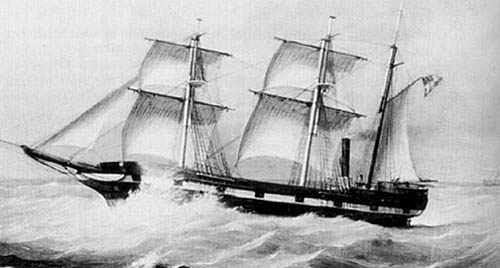
Auxiliary Steam Packet Bark Edith, 1849
Click on this photograph for links to larger images of this class.
Class: EDITH
Design: Auxiliary steam packet (bark rig)
Displacement (tons): 407 (tonnage)
Dimensions (feet): 120.0' x 26.0' x 14.0' depth
Original Armament: 2 guns
Later armaments: --
Complement: 25
Speed (kts.): --
Propulsion (HP): --
Machinery: Direct acting condensing engines with one tubular boiler, 1 hoisting screw.
Construction:
| AF | Name | Acq. | Builder | Keel | Launch | Commiss. |
| -- | EDITH | 3 Mar 49 | Samuel Hall | -- | 1844 | ca Jun 49 |
Disposition:
| AF | Name | Decomm. | Strike | Disposal | Fate | MA Sale |
| -- | EDITH | -- | -- | 24 Aug 49 | Lost | -- |
Class Notes:
The Boston merchant ship owner Robert Bennet Forbes was a firm believer in an alternative type of steam vessel, which was primarily a sailing ship but which had a small auxiliary steam engine for use when winds were unfavorable or in restricted waters. With compact machinery and coal capacity for only part of the voyage such a ship had a lot of internal space. This concept found little favor in America, where steamers with full engine power were preferred, but Forbes, who was primarily interested in the Oriental trade, thought that auxiliary steamships would be suitable for that trade, as no existing full powered steamer could carry enough coal for so long a trip. Forbes' first experiment was the 148-ton, 100-foot auxiliary steam topsail schooner MIDAS built by Samuel Hall at Boston in 1844. John Ericsson designed her machinery and gave her complex twin screws, and Forbes sent her out to China. Her machinery suffered badly on the trip but as long as her boiler lasted she served as a tug between Hong Kong and Canton.
The somewhat larger EDITH was Forbes' second experiment, also built by Hall and with machinery designed by Ericsson. Her engines were built by the Delamater Iron Works and were powered by a single tubular boiler. Ericsson replaced the twin screws of MIDAS with a single propeller whose shaft ran though the hull at one side of the sternpost and which was carried on a pivoted bracket that could be swung sideways and upward to lift the propeller out of the water while the ship was under sail. The propeller was placed abaft the rudder and the latter was slotted to clear its shaft. EDITH sailed from New York for British India on 18 January 1845 and was the first American steamer to visit there. In India British underwriters refused to insure her, and she then proceeded from Bombay to China in 21 and 1/2 days, the fastest such passage to date. She was the first American square-rigged screw steamer seen in China. However shippers there feared that the heat from her furnaces would damage opium, and as long as there were other craft available she lay without cargo. Eventually, like MIDAS, she had her propeller removed and sailed home.
After her machinery was put back into order, she was first chartered to and then purchased by the War Department for use as a transport in the Gulf of Mexico during the Mexican War. After the war she was sent to the Pacific Coast, arriving at San Francisco on 21 March 1849, 134 days out of New York. She made the passage in 110 running days, of which she steamed fifteen. While at sea she was transferred from the Army to the Navy under Congressional legislation of 3 March 1849 and assigned to the Pacific Squadron. On 16 June 1849 Lieutenant James McCormick was ordered to report on the condition of the steamer, subsequently he was placed in temporary command with orders to transport representatives to the California State Constitutional Convention. EDITH departed Sausalito on 23 August 1849 en route to Santa Barbara but encountered dense fog which made it impossible to see land or get an observation. On the morning of 24 August she ran aground near Point Arguello, probably on one of the beaches above the rocky point. All her crew and most of her furniture and provisions were saved, but salvage efforts failed when she bilged and filled with water. A court of inquiry held in January 1850 exonerated her commander and crew from any guilt.
Much of the information in these notes, and some in the notes for MASSACHUSETTS, comes from an article by Cedric Ridgely-Nevitt, "Auxiliary Steamships and R. B. Forbes," in the American Neptune, volume 1, 1941, pages 51 to 57, which is available on the Internet.
Ship Notes:
| AF | Name | Notes |
| -- | EDITH | Ex merc. EDITH. Transferred from the Army 3 Mar 49. Wrecked near Point Arguello, California, 24 Aug 49. |
Page Notes:
AF 1849
Compiled: 07 Jul 2013
© Stephen S. Roberts, 2002-2013